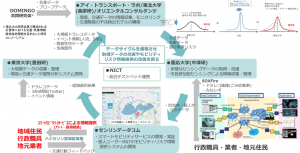Regional IoT and Information Technology Research Consortium/ Shonan IoT Promotion Lab.
SFCity Project
“Regional IoT and Information Technology Research Consortium” is an industry-government-academia collaborative research project established at SFC research institute of Keio University. Using regional IoT technology to comprehensively sense all information in the city and data processing technology to generate powerful information affecting human behavior, we are promoting research to make the city smarter. The purpose of this consortium is to make people’s lives in the city richer, more enjoyable, safer, smarter and more convenient by creating services that utilize the power of information. A network has been established between stakeholders of industry, government, and academia, and a system has been established to continuously engage in various information exchanges, technology development, business development, etc. we are looking for members of this consortium. Once you become a member, you will be able to participate in consortium-sponsored symposium, events, study sessions, and technical tutorials, as well as free use of research results (with support from some of the researchers).

Health information consortium
In the health information consortium, we are conducting research and development by collaborating with industry, government, and academia. We are focusing on various themes such as women, bones, smiles, and the elderly by making full use of various IoT/AI technologies in anticipation of a 100 year life era.

NICT BigClouT project
Big data meeting cloud and IoT for empowering the citizen clout in smart cities
BigClouT conducts commissioned research in collaboration with the National Institute of Information and Communications Technology (NICT) and the European Commission (EC), jointly conducted by 12 institution in Japan and Europe, including Nakazawa Lab. We are developing a platform for Big data utilization to collect, manage and analyze vast and diverse public data obtained from IoT sensors, open data, web, etc. This is done in an integrated and efficient manner using wireless sensor networks technology development. While keeping an eye on international standardization and working on collaborative research and development with Europe, we will contribute to solving social issues and creating new services through an information and communication platform that uses common elemental technologies.

NICT M-Sec Project
The M-Sec project is a commissioned research project conducted by the National Institute of Information and Communications Technology in cooperation with the European Commission’s Horizon 2020, and is being jointly promoted by 12 institutions in Japan and Europe, including the Nakazawa Laboratory. This is a Japanese-European joint research and development project titled “Multilayer Security Technology for Hyper Connected Smart Cities Using Blockchain, Big Data Cloud and IoT”. The main purpose of the M-Sec project is to research, develop, deploy, and
demonstrate multi-layer security technologies that guarantee hyper connected smart cities, and to develop innovative technologies utilizing blockchain, big data, cloud, and IoT security to enable IoT stakeholders to build innovative smart city applications through the platform.

NICT SSM Project
NICT SSM Project Mobility Risk Information Generation Platform’s Experimental Research Development.
The SSM project is collaborating with the National Institute of Information and Communications Technology on research and development of a smart mobility platform through interdisciplinary data collaboration by six institutions, including the Nakazawa Laboratory, the University of Tokyo, Tohoku University, and Zenrin Datacom. In order to realize these smart and highly sustainable transportation service utilizing the interdisciplinary data linkage platform on the NICT comprehensive testbed, in other words, the Smart Sustainable Mobility (from hereon SSM) services, we will do the following: (1) Collect, integrate, and analyze the environmental data (weather data, etc.) and traffic data (probe data, etc.) from various data sources so that we can distribute and use the results. (2) Implement a technology system that will make use of the data platform and predict in real time the mobility risk that can have an affect on the movement of cars and humans. (3) Research and develop SSM services from the data platform and the mobility risk prediction results that can solve the transportation problems within each region. As for the SSM services we are going to develop, we will conduct a hackathon-type demonstration experiment open to local residents, organizations, companies, local governments, and other users, and obtain feedback to increase its practicality.

